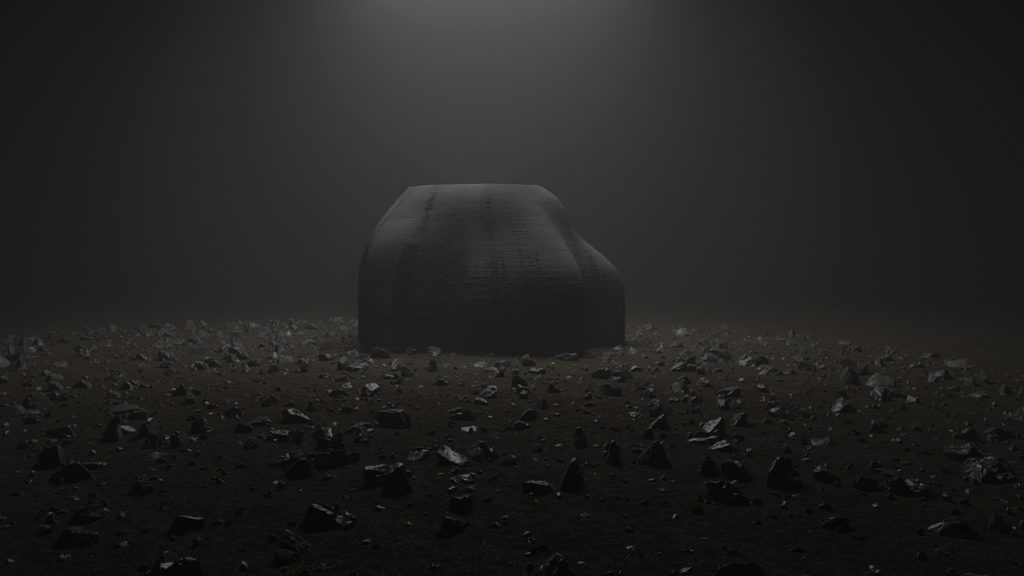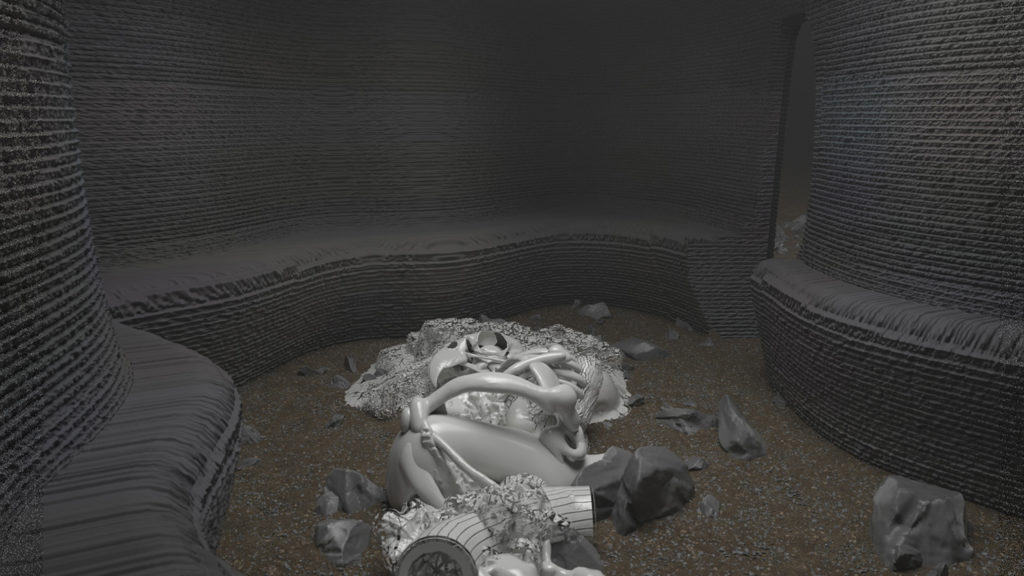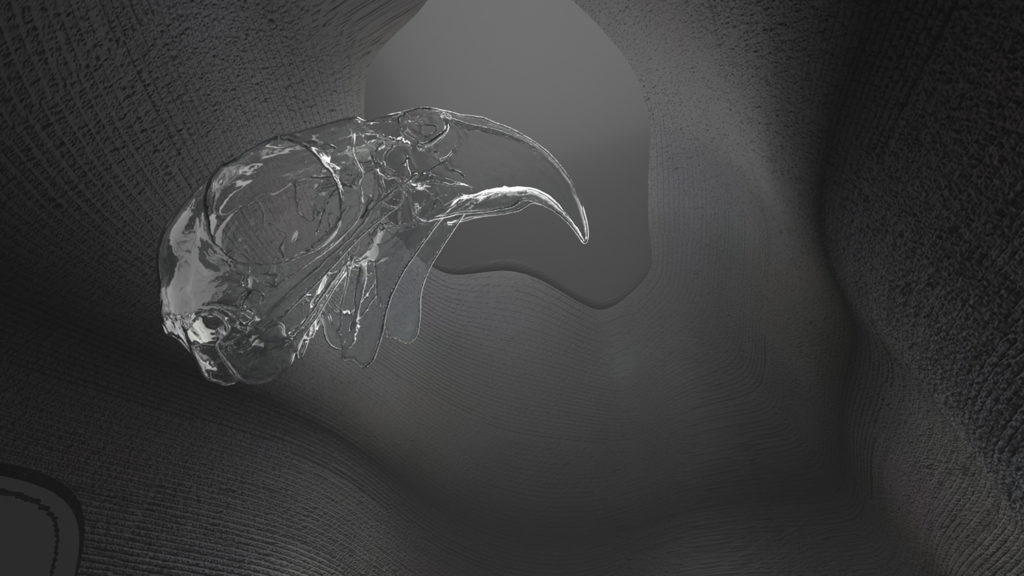Refuges

On marche le long d’un rivage. Une plage, du sable et des rochers, une jetée peut être, le vent. Le flux et le reflux de l’océan, son lourd écho et son imperceptible grondement. On voit au loin une forme qui se détache. D’abord imprécise, elle pourrait être une île échouée s’enfonçant imperceptiblement dans le sable. Puis se dessinant lentement et apparaissant comme une architecture étrange qui pourrait faire penser à un bunker. Mais les formes n’en ont pas le caractère rectiligne et austère. Le bâtiment-île est en courbes, irrégulières et subtiles.

On s’approche encore jusqu’à en apercevoir le détail et les textures de béton strié, des lignes comme tressées les unes aux autres, fragiles et pourtant solides au toucher. Le silence règne.
On en fait le tour, comme l’inspectant. On pose la main sur les lignes qu’on suit peut-être du doigt percevant le sable qui s’est incrusté au fil du temps. Juste là, derrière, une large entrée. On y jette un regard. On entre.

À l’intérieur, le plafond est ouvert laissant entrer les intempéries, la pluie et le soleil, comme à découvert, exposé au-dehors. Sur les côtés, comme une protubérance des murs, un banc dessinant le contour, et au centre de l’espace une autre forme, organique, difficilement descriptible. Elle pourrait faire penser à un gisant.
C’est un corps s’enfonçant par endroit dans le sable, composé d’un ensemble disparate comme s’il n’était pas identique à lui-même, mais une composition des plus étranges entre des organismes, des végétaux, des minéraux. Tous les règnes semblent s’y mêler comme si ce corps n’était pas stabilisé et hésitait, tout autant qu’il était arrêté, dans sa métamorphose. C’est un corps vitrifié, fossilisé, blanc et lisse. On aperçoit sur ses côtés des lignes plonger, à la manière d’un « displacement glitch » où on prend des pixels et où on les tire.

On fixe avec la caméra de son téléphone, la sculpture centrale. Un moment de pause puis, comme des spectres, des formes en réalité augmentée apparaissent en transparence bleutée. Ce sont des fragments de corps, des morceaux de plantes ou de minéraux qui flottent au-dessus de ce corps métamorphique. Tout se passe comme si ces éléments lévitaient, on comprend bien qu’ils sont des composants de cet organisme monstrueux. Un moment encore et certains des fragments s’élèvent un peu plus. On les suit avec l’appareil et on les voit sortir par l’ouverture du plafond tandis qu’une voix nous raconte l’histoire imaginaire de cet organisme, de tous les organismes, quels qu’en soient le règne et l’époque, sur Terre.

REFUGES est une installation architecturale et sculpturale pérenne en réalité augmentée pouvant se déployer dans plusieurs lieux.
Comme son titre l’indique, il s’agit d’un refuge à la temporalité incertaine, passée, présente et tout à la fois future, le bâtiment tente de protéger un organisme qui traverse les frontières entre les règnes animaux, végétaux et minéraux en une métamorphose suspendue dans son effet de traîne.
Volontairement ambigu, le dispositif est installé à proximité du rivage, là où la prochaine montée des eaux pourrait le submerger et le transformer en un massif coralien, tel un refuge futur pour des animaux aquatiques. Cette précarité entre en tension avec le matériau, le béton, qui fait dans cette région référence aux nombreux bunkers et au patrimoine industriel. Mais ici la construction est organique, tissée de colombages, ondoyant. A mi-chemin entre l’architecture et la topologie, cette impression en béton est générée par une intelligence artificielle, ou réseaux récursifs de neurones, faisant la synthèse d’une base de données exhaustive des 460 000 îles existantes. Le refuge devient alors une utopie, un non-lieu, celui d’une île possible.
A l’intérieur, un moulage réalisé à partir d’une impression additive, représente un corps en une position mortuaire. Ce gisant est lui-même une synthèse entre des règnes hétérogènes qui communiquent entre eux sur Terre, l’organique, le végétal, le minéral. Le corps n’est pas unifié, il est constitué de plusieurs éléments, tentant d’opérer une impossible synthèse. C’est un corps de corps, un corps-monde qui est celui-là même de l’énergie, et en particulier du pétrole, fruit de la décomposition de corps passés que nous brûlons et qui embrase la planète. L’idée de l’énergie comme consumation des vies passées qui rend inhabitable la planète pour les vies présentes est centrale.
La réalité augmentée est spectracle. Elle permet de détacher les fragments du corps à la manière de simulacres épicuriens : ces pellicules de peaux s’échappant et permettant à un autre corps de les percevoir. On y retrouve des éléments se trouvant dans la région : des animaux, des plantes, des roches. C’est une impossible tentative de catalogue d’un monde en train de disparaître et dont la résurrection est ici suspendue à sa possibilité. Du corps en métamorphose s’échappe donc une mémoire des corps.
Dans Amers (1957), Saint-John Perse écrit “L’inhabitable est notre site”. Refuges parle de mondes anciens et de mondes nouveaux, d’un crépuscule et d’une aurore incertaine et ambiguë. Les rivages sont des zones critiques de la crise climatique, une lisière qui délimite notre monde et qui en dessine les contours par le travail constant de l’érosion. REFUGES est un bâtiment de recueillement et de silence. C’est un monument à une métamorphose à venir, à des formes qui se transforment et qui sont faites de la même matière, en transition continuelle du passé au futur.
Son implantation locale fait non seulement référence à des constructions humaines (bunker, industrie, activité portuaire) mais aussi à des représentants de règnes spécifiques : le gisant est composé de plusieurs formes existantes à proximité. On numérisera grâce à un scanner 3D des animaux, des pierres, des plantes, comme si nous savions qu’elles allaient disparaître et que nous devions en préserver la mémoire et leur possibilité à venir.
C’est autour du trouble entre les temporalités passées et futures que naît ici une nouvelle forme de refuge selon une logique du futur antérieur.
Avec Goliath Dyèvre
–
We walk along a shoreline. A beach, sand and rocks, a pier perhaps, the wind. The ebb and flow of the ocean, its heavy echo and its imperceptible rumbling. We see in the distance a shape that stands out. At first imprecise, it could be a stranded island imperceptibly sinking into the sand. Then it slowly takes shape and appears as a strange architecture that could remind us of a bunker. But the forms do not have the rectilinear and austere character. The building-island is in curves, irregular and subtle.
We get closer until we see the details and textures of striated concrete, lines as if braided together, fragile and yet solid to the touch. Silence reigns.
One goes around it, as if inspecting it. One puts the hand on the lines that one follows perhaps with the finger perceiving the sand which was encrusted with the wire of time. Just there, behind, a broad entry. One throws a glance there. One enters.
Inside, the ceiling is open, letting in the weather, the rain and the sun, as if exposed to the outside. On the sides, as a protrusion of the walls, a bench drawing the outline, and in the center of the space another form, organic, difficult to describe. It could make think of a recumbent.
It is a body sinking by place in the sand, composed of a disparate whole as if it were not identical to itself, but a composition of the strangest between organisms, plants, minerals. All the kingdoms seem to mingle there as if this body was not stabilized and hesitated, as much as it was stopped, in its metamorphosis. It is a vitrified body, fossilized, white and smooth. We see on its sides lines plunging, in the manner of a “displacement glitch” where we take pixels and pull them.
One fixes with the camera of his telephone, the central sculpture. A moment of pause, then, like spectres, forms in augmented reality appear in bluish transparency. They are fragments of bodies, pieces of plants or minerals that float above this metamorphic body. Everything happens as if these elements were levitating, we understand that they are components of this monstrous organism. One moment still and some of the fragments rise a little more. We follow them with the camera and we see them coming out of the opening in the ceiling while a voice tells us the imaginary story of this organism, of all organisms, whatever the kingdom and the time, on Earth.
REFUGES is a perennial architectural and sculptural installation in augmented reality that can be deployed in several places.
As its title indicates, it is a refuge with an uncertain temporality, past, present and at the same time future, the building tries to protect an organism which crosses the borders between the animal, vegetable and mineral kingdoms in a metamorphosis suspended in its drag effect.
Deliberately ambiguous, the device is installed close to the shore, where the next rise in water could submerge it and transform it into a coral mass, like a future refuge for aquatic animals. This precariousness enters into tension with the material, concrete, which in this region refers to the numerous bunkers and industrial heritage. But here the construction is organic, woven with half-timbering, undulating. Halfway between architecture and topology, this concrete impression is generated by an artificial intelligence, or recursive neural networks, synthesizing an exhaustive database of the 460 000 existing islands. The refuge then becomes a utopia, a non-place, that of a possible island.
Inside, a molding made from an additive printing, represents a body in a mortuary position. This recumbent is itself a synthesis between heterogeneous kingdoms that communicate with each other on Earth, the organic, the vegetable, the mineral. The body is not unified, it is made up of several elements, trying to operate an impossible synthesis. It is a body of bodies, a body-world which is that of energy, and in particular of oil, fruit of the decomposition of past bodies that we burn and which sets the planet on fire. The idea of energy as the consumption of past lives that makes the planet uninhabitable for present lives is central.
Augmented reality is spectracle. It allows fragments of the body to be detached in the manner of Epicurean simulacra: these films of skin escaping and allowing another body to perceive them. One finds elements found in the region: animals, plants, rocks. It is an impossible attempt to catalog a world in the process of disappearing and whose resurrection is suspended here on its possibility. From the body in metamorphosis thus escapes a memory of the bodies.
In Amers (1957), Saint-John Perse writes “The uninhabitable is our site”. Refuges speaks of old worlds and new worlds, of a twilight and an uncertain and ambiguous dawn. The shores are critical zones of the climate crisis, an edge that delimits our world and draws its contours through the constant work of erosion. REFUGES is a building of recollection and silence. It is a monument to a future metamorphosis, to forms that transform and are made of the same material, in continuous transition from the past to the future.
Its local location refers not only to human constructions (bunker, industry, port activity) but also to representatives of specific kingdoms: the recumbent is composed of several existing forms in the vicinity. Animals, stones, plants are digitized with a 3D scanner, as if we knew they were going to disappear and that we had to preserve their memory and their future possibility.
It is around the confusion between past and future temporalities that a new form of refuge is born here according to a logic of the future before.
With Goliath Dyevre
